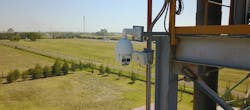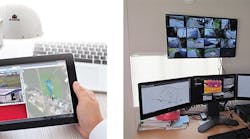Radar Proves an Effective Security Option to Protect the Grid
It’s no secret that we rely on the grid for just about everything, from our cell phones to public transportation to our national defense systems. We are heavily dependent on the electricity we use every day. For this reason, it is vital that the electric grid, specifically the power plants, electrical substations and transmission lines that comprise it, remain safe and secure.
Electrical utility substations are commonly located in rural areas, set up on large plots of land making it difficult to effectively secure and patrol. In recent years, substations have become a major target for intrusion and sabotage. After the Metcalf sniper attack of 2013, a sophisticated assault on a Pacific Gas and Electric Company's transmission substation supplying power to California’s Silicon Valley, it was clear that new precautions needed to be implemented to safeguard these locations. In 2014, the Wall Street Journal reported that a Federal Energy Regulatory Commission (FERC) study found that if nine of the United States’ key electrical substations, or less than 0.01 percent of the 55,000 substations in the nation, became inoperable, the U.S. would be without power for over 18 months. These facts underscore how critical it is for utility companies to implement advanced perimeter security technologies that can detect and deter intruders approaching the site.
Early detection is the key to preventing physical security breaches for electrical substations throughout the country, and this is where radar comes into play. Radar stands for “Radio Detection And Ranging,” and while the technology itself is simple, its effect is substantial. Radar offers 24/7 360-degree coverage allowing for cost-effective, volumetric perimeter protection in all weather and lighting conditions. When installed, radar creates a virtual boundary around a substation, and the value of this technology is that it’s able to detect threats long before they reach the fence line. While many traditional perimeter security methods, such as cameras or fiber optics, can be limited by environmental factors and plagued by false alarms, radar has found a way to perform optimally no matter the conditions all while keeping the nuisance alarm rate (NAR) at a minimum.
Introduction to Radar
Historically, radar has been utilized in military and government operations. For this reason, many security professionals have viewed radar as a DoD technology. However, greater production of radar solutions has brought the price point of the technology down, opening the door to more applications for the commercial market. This evolution has led to radar becoming a viable option for applications with wide area and perimeter monitoring needs that security directors should consider.
In simple terms, radar is an object detection system, employing radio waves to determine an object’s range, speed, altitude and direction of movement. Yielding a wider coverage than any other sensor with 120-degrees in azimuth, and 30-degrees in elevation, a single radar can easily cover any changing environment. Midsize radars have the ability to detect vehicles or boats up to 1000 meters away, and humans over 700 meters away.
More advanced radar solutions designed for long-range detection include multiple input multiple output (MIMO) technology, allowing for an angular resolution of six to seven degrees. This is crucial for detection performance in rural or more cluttered environments‑ think of a densely wooded area with trees that move in the wind right next to the fence of a substation. This feature ensures that foliage will not trigger false alerts within the system.
Low weight, low power consumption, and low required bandwidth are other distinguishing features of radar. Standard radar units weigh less than four pounds, and they can be easily mounted onto existing poles, buildings and other infrastructure. Thanks to wireless communications and solar power options, radars can be deployed both on and off site. Using radar as a deployable system, security forces can place radar at off-site locations, monitoring field, forests, or other points of access to the property that may be far removed from the substation itself. Radars that are placed offsite are still able to fully communicate with the rest of the onsite solution, allowing for earlier alerting capabilities and giving security forces ample time to react to situations before they escalate.
How Radar Compares to Other Technologies
Following the 2013 Metcalf attack, FERC established new security standards for utilities, the most important policy for asset protection being the Critical Infrastructure Protection Standard 014 (CIP-014), which specifically introduced new, and more advanced security requirements for substations. CIP-014 specifies that each facility must identify “mission critical” assets, administer a thorough security risk assessment, and deploy the appropriate security technologies to address any vulnerabilities.
To comply with these new requirements many utilities found themselves buying costly fiberoptic fencing systems. While effective for carrying a signal long distances, fiberoptic fencing may not be ideal for perimeter security. Physical fencing calls for complex installations, digging trenches and running miles of cabling, which can still result in a system which outputs a high NAR.
Other energy firms have deployed thermal cameras for perimeter surveillance. These cameras create images based on the heat emitted from all, objects so they are effective for video capture in total darkness. On the other hand, thermal cameras can be affected by severe weather such as heavy rain. Substantial rainfall can reduce the recognition range of a tradition thermal camera from 320 meters to less than 100 meters. Additionally, fixed thermal cameras mounted along the fence line can be limited in their coverage, providing a narrow field of view.
In contrast, radar allows utility companies to comply with CIP-014, yielding optimal detection performance while keeping the total cost of ownership down. Unlike fiber optic fencing systems, a radar can be installed in just a few hours, making installations less labor intensive and keeping equipment costs to a minimum. With its wide area coverage, a single radar can easily replace 10 video motion detection or thermal cameras. When deploying two or more radars, they can detect targets both along the fence line and inside the field, eliminating dead zones. While infrared radiation is absorbed by water droplets, reducing the detection range of IR cameras, the radio frequency waves that radar utilizes don’t “see” water droplets. In other words, rain and fog do not inhibit a radar’s detection capabilities.
Advanced Integrations and Deployment
Another important characteristic of radar is that it can seamlessly integrate with systems and software to create a more wholistic perimeter security solution. Through the video management system (VMS), radar can pair with pan-tilt-zoom (PTZ) cameras and video analytics to enable security personnel to detect, track, watch, and analyze threats, all within mere seconds. Here is how it works. When the radar detects an object, it analyzes its movement to determine if it is an object of true concern or just surrounding wildlife running by. After filtering out nuisance alerts, the radar outputs the validated target tracks into the VMS, directly cueing a PTZ camera to the location of the target. As the PTZ camera follows the target, security forces can watch a live stream for further threat assessment and verification.
More advanced integrated solutions combine radar, video and deep learning technologies. Signals from the radar are analyzed alongside a video stream with deep learning classification software, allowing the solution to determine whether the target is a human or vehicle. Once the target is classified and validated, which all takes less than a second, the VMS will send an alert to security personnel while simultaneously logging a record of the event. Some solutions are able to take it a step further by then deploying an autonomous drone to the target location for real-time response, using two-way audio capabilities to determine whether the individual is an employee or a suspect breaking and entering.
When it comes to deploying radar, many external and physical factors should be considered. When looking to install radar onsite, it is best to work with a systems integrator with a proven track record of accurately assessing substation environmental conditions and effectively configuring radar solutions to fit the needs of the individual property. For example, depending upon the topography of the region, the radar may need to be mounted higher up on a pole to maximize its elevation coverage. This allows it to capture movement from all relevant targets, whereas if the radar is placed too close to the ground, it may be blocked by structures or hills onsite. For best practices and recommendations specific to your site, consult your integrator.
Cost-Savings and ROI
The defining advantage of radar for security directors is its ability to provide intrusion detection for perimeter applications in a cost-effective manner. With a single radar able to reliably cover the same area as 10 cameras, security operators can save thousands of dollars in equipment costs alone. Low maintenance generates an additional cost-savings. Fixed radar allows security managers to drastically lower upkeep costs by utilizing technology with immobile parts, unlike rotating radar which incorporates moving pieces that require more maintenance.
When deploying perimeter systems that utilize radar, the solution can effectively reduce the number of security patrol officers needed onsite, which lowers security expenses. With some salaries reaching six figures for a 24-hour security guard, it can be difficult for utilities to accommodate the expense in their budget. However, a perimeter solution with radar, video and deep learning technologies can detect, track and make decisions on a target without human intervention. By also filtering out nuisance alerts, the odds of security guards and the police being dispatched for false alarms is greatly reduced. This saves time, money and key resources while also allowing the perimeter solution to act as a force multiplier for a utility’s security personnel.
Another cost-saving advantage of radar is the fact that it does not require a lot of storage space for needless data. Other surveillance technologies, such as video cameras, require constant recording that must be stored, only to be utilized when an incident occurs. This requires substantial storage in the cloud or on physical servers, which can quickly eat into security budgets. On the other hand, radar only records upon a target detection, freeing up storage space and bandwidth simultaneously.
An Effective Option
No longer is radar primarily a solution for governments and militaries. Radar technology has been making leaps and bounds within recent years, allowing its functionality and price point to match perfectly for the industrial markets. With all condition performance, wide coverage, and low total cost of ownership, it has positioned itself as an attractive offering for perimeter protection systems.
About the author: Yaron Zussman is the General Manager of the America division of Magos. Founded in 2007 in Israel, Magos provides state-of-the-art radar solutions for power plants, data centers, oil refineries and critical infrastructure sites. When Magos launched its USA office in March 2018, Zussman was appointed to spearhead the new division. Prior to his position at Magos, Zussman was the CEO of FST Biometrics America, and before that, Vice President of Sales- Americas & Global Accounts at DVTEL. Zussman brings over 15 years of security experience. He can speak to radar technology in the security marketplace and its journey from the defense industry to the commercial market.






